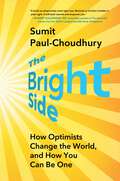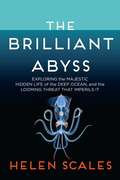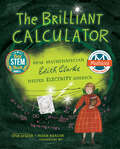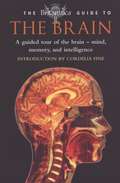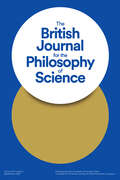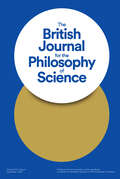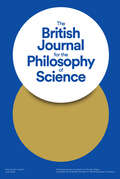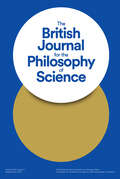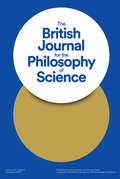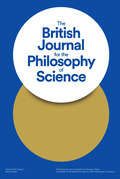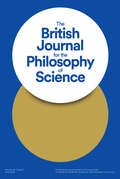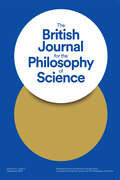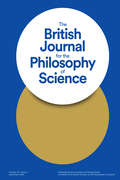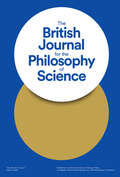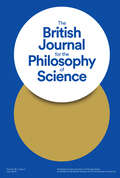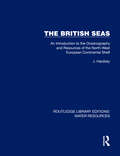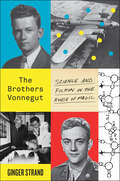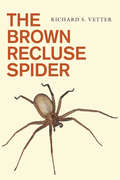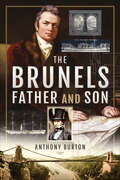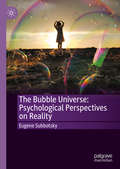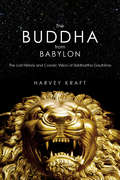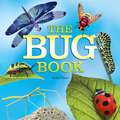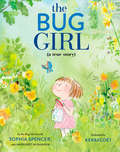- Table View
- List View
The Bright Side: How Optimists Change the World, and How You Can Be One
by Sumit Paul-ChoudhuryIn the thought-provoking tradition of Steven Pinker&’s Enlightenment Now and Yuval Noah Harari&’s Homo Deus, a fascinating and reassuring look at the philosophy, psychology, and practice of optimism, and why being optimistic is a moral obligation—even in the face of seemingly insurmountable challenges.Scrolling through our daily newsfeeds we see violence and cruelty, turmoil and injustice, fake news and clickbait, and worsening environmental and social crises—just a few of the dark currents feeding a tidal wave of pessimism. In the face of so many challenges, how can we stay optimistic? And, more important, why should we? In The Bright Side, Sumit Paul-Choudhury answers these pressing questions, arguing that optimism is not only essential for overcoming the challenges we face, but also fundamental to human wellbeing. Drawing on a wide array of evidence—from biology to history, and from economics to meteorology—he delves into the underappreciated roots of optimism, examines its impact on mental health and professional success, and discusses why it has a power that wishful thinking lacks. Additionally, The Bright Side shows how we can apply the principles of optimism to cope with environmental crises, artificial intelligence, and social change. From the polar reaches to the world&’s mightiest cities, through inspirational figures including explorers, activists, and scientists, the book illustrates optimism in action. A beacon amid dark times, The Bright Side provides a lens through which we can see the challenges we face more clearly—and it also offers tools for solving them, to create a better future for ourselves and generations to come.
The Brilliant Abyss: Exploring the Majestic Hidden Life of the Deep Ocean, and the Looming Threat That Imperils It
by Helen ScalesA journey into the alien depths of the sea, and into our possible future, from a marine biologist known for &“nature writing at its most engaging&” (Sunday Express). A golden era of deep-sea discovery is underway as revolutionary studies rewrite the very notion of life on Earth and the rules of what is possible. In the process, the abyss is being revealed as perhaps the most amazing part of our planet, its topography even more varied and extreme than its landmass counterpart. Teeming with unsuspected life, an extraordinary, interconnected ecosystem deep below the waves has a huge effect on our daily lives, influencing climate and weather systems, with the potential for much more—good or bad, depending on how it is exploited. Currently, the fantastic creatures that live in the deep—many of them incandescent in a world without light—and its formations capture and trap vast quantities of carbon that would otherwise poison our atmosphere, and novel bacteria as yet undiscovered hold the promise of potent new medicines. Yet the deep also holds huge mineral riches lusted after by nations and corporations; mining them could ultimately devastate the planet, compounded by the deepening impacts of ubiquitous pollutants and rampant overfishing. Eloquently and passionately, the author of Spirals in Time and Eye of the Shoal brings to life the majesty and mystery of an alien realm that nonetheless sustains us, while urgently making clear the price we could pay if it is further disrupted. The Brilliant Abyss is at once a revelation and a clarion call to preserve this vast unseen world.
The Brilliant Calculator: How Mathematician Edith Clarke Helped Electrify America
by Jan LowerHidden Figures meets Rosie Revere, Engineer in this STEM/STEAM picture book about Edith Clarke, the innovator who solved an electrical mystery and built the first graphing calculator—from paper!Long before calculators were invented, little Edith Clarke devoured numbers, conquered calculations, cracked puzzles, and breezed through brainteasers. Edith wanted to be an engineer—to use the numbers she saw all around her to help build America.When she grew up, no one would hire a woman engineer. But that didn&’t stop Edith from following her passion and putting her lightning-quick mind to the problem of electricity. But the calculations took so long! Always curious, Edith couldn&’t help thinking of better ways to do things. She constructed a &“calculator&” from paper that was ten times faster than doing all that math by hand! Her invention won her a job, making her the first woman electrical engineer in America. And because Edith shared her knowledge with others, her calculator helped electrify America, bringing telephones and light across the nation.
The Britannica Guide to the Brain
by Encyclopaedia BritannicaThe human brain has been studied for millennia, but in the past decades huge advances have occurred in neurology that have allowed scientists to reassess what we really know about the least understood part of the human body. Using technology that allows researchers to see deeper into the physical organ and record new discoveries, the latest theories affect not just our understanding of biology but also raise questions concerning consciousness, the mind and neuro-plasticity. We can now observe the activity of the brain as it performs different functions; with scanning technology we can chart the neural pathways and devise maps. The explorations have revealed surprising results. The Britannica Guide series offers an essential introduction to many of the key issues of our times. Clear, accurate, and meticulously researched the series gives both the background and analysis for when you need to know for sure what is really happening in the world, whether you are an expert, student or traveller.
The British Journal for the Philosophy of Science, volume 73 number 3 (September 2022)
by The British Journal for the Philosophy of ScienceThis is volume 73 issue 3 of The British Journal for the Philosophy of Science. Since 1950, The British Journal for the Philosophy of Science (BJPS) has presented the best new work in the discipline. An international leader in the philosophy of science, BJPS showcases outstanding research on a variety of topics, from the nature of models and simulations to mathematical explanation and foundational issues in the physical, life, and social sciences. Published on behalf of the British Society for the Philosophy of Science, the journal offers innovative and thought-provoking papers that open up new areas of inquiry or shed new light on well-known issues.
The British Journal for the Philosophy of Science, volume 73 number 4 (December 2022)
by The British Journal for the Philosophy of ScienceThis is volume 73 issue 4 of The British Journal for the Philosophy of Science. Since 1950, The British Journal for the Philosophy of Science (BJPS) has presented the best new work in the discipline. An international leader in the philosophy of science, BJPS showcases outstanding research on a variety of topics, from the nature of models and simulations to mathematical explanation and foundational issues in the physical, life, and social sciences. Published on behalf of the British Society for the Philosophy of Science, the journal offers innovative and thought-provoking papers that open up new areas of inquiry or shed new light on well-known issues.
The British Journal for the Philosophy of Science, volume 74 number 2 (June 2023)
by The British Journal for the Philosophy of ScienceThis is volume 74 issue 2 of The British Journal for the Philosophy of Science. Since 1950, The British Journal for the Philosophy of Science (BJPS) has presented the best new work in the discipline. An international leader in the philosophy of science, BJPS showcases outstanding research on a variety of topics, from the nature of models and simulations to mathematical explanation and foundational issues in the physical, life, and social sciences. Published on behalf of the British Society for the Philosophy of Science, the journal offers innovative and thought-provoking papers that open up new areas of inquiry or shed new light on well-known issues.
The British Journal for the Philosophy of Science, volume 74 number 3 (September 2023)
by The British Journal for the Philosophy of ScienceThis is volume 74 issue 3 of The British Journal for the Philosophy of Science. Since 1950, The British Journal for the Philosophy of Science (BJPS) has presented the best new work in the discipline. An international leader in the philosophy of science, BJPS showcases outstanding research on a variety of topics, from the nature of models and simulations to mathematical explanation and foundational issues in the physical, life, and social sciences. Published on behalf of the British Society for the Philosophy of Science, the journal offers innovative and thought-provoking papers that open up new areas of inquiry or shed new light on well-known issues.
The British Journal for the Philosophy of Science, volume 74 number 4 (December 2023)
by The British Journal for the Philosophy of ScienceThis is volume 74 issue 4 of The British Journal for the Philosophy of Science. Since 1950, The British Journal for the Philosophy of Science (BJPS) has presented the best new work in the discipline. An international leader in the philosophy of science, BJPS showcases outstanding research on a variety of topics, from the nature of models and simulations to mathematical explanation and foundational issues in the physical, life, and social sciences. Published on behalf of the British Society for the Philosophy of Science, the journal offers innovative and thought-provoking papers that open up new areas of inquiry or shed new light on well-known issues.
The British Journal for the Philosophy of Science, volume 75 number 1 (March 2024)
by The British Journal for the Philosophy of ScienceThis is volume 75 issue 1 of The British Journal for the Philosophy of Science. Since 1950, The British Journal for the Philosophy of Science (BJPS) has presented the best new work in the discipline. An international leader in the philosophy of science, BJPS showcases outstanding research on a variety of topics, from the nature of models and simulations to mathematical explanation and foundational issues in the physical, life, and social sciences. Published on behalf of the British Society for the Philosophy of Science, the journal offers innovative and thought-provoking papers that open up new areas of inquiry or shed new light on well-known issues.
The British Journal for the Philosophy of Science, volume 75 number 2 (June 2024)
by The British Journal for the Philosophy of ScienceThis is volume 75 issue 2 of The British Journal for the Philosophy of Science. Since 1950, The British Journal for the Philosophy of Science (BJPS) has presented the best new work in the discipline. An international leader in the philosophy of science, BJPS showcases outstanding research on a variety of topics, from the nature of models and simulations to mathematical explanation and foundational issues in the physical, life, and social sciences. Published on behalf of the British Society for the Philosophy of Science, the journal offers innovative and thought-provoking papers that open up new areas of inquiry or shed new light on well-known issues.
The British Journal for the Philosophy of Science, volume 75 number 3 (September 2024)
by The British Journal for the Philosophy of ScienceThis is volume 75 issue 3 of The British Journal for the Philosophy of Science. Since 1950, The British Journal for the Philosophy of Science (BJPS) has presented the best new work in the discipline. An international leader in the philosophy of science, BJPS showcases outstanding research on a variety of topics, from the nature of models and simulations to mathematical explanation and foundational issues in the physical, life, and social sciences. Published on behalf of the British Society for the Philosophy of Science, the journal offers innovative and thought-provoking papers that open up new areas of inquiry or shed new light on well-known issues.
The British Journal for the Philosophy of Science, volume 75 number 4 (December 2024)
by The British Journal for the Philosophy of ScienceThis is volume 75 issue 4 of The British Journal for the Philosophy of Science. Since 1950, The British Journal for the Philosophy of Science (BJPS) has presented the best new work in the discipline. An international leader in the philosophy of science, BJPS showcases outstanding research on a variety of topics, from the nature of models and simulations to mathematical explanation and foundational issues in the physical, life, and social sciences. Published on behalf of the British Society for the Philosophy of Science, the journal offers innovative and thought-provoking papers that open up new areas of inquiry or shed new light on well-known issues.
The British Journal for the Philosophy of Science, volume 76 number 1 (March 2025)
by The British Journal for the Philosophy of ScienceThis is volume 76 issue 1 of The British Journal for the Philosophy of Science. Since 1950, The British Journal for the Philosophy of Science (BJPS) has presented the best new work in the discipline. An international leader in the philosophy of science, BJPS showcases outstanding research on a variety of topics, from the nature of models and simulations to mathematical explanation and foundational issues in the physical, life, and social sciences. Published on behalf of the British Society for the Philosophy of Science, the journal offers innovative and thought-provoking papers that open up new areas of inquiry or shed new light on well-known issues.
The British Journal for the Philosophy of Science, volume 76 number 2 (June 2025)
by The British Journal for the Philosophy of ScienceThis is volume 76 issue 2 of The British Journal for the Philosophy of Science. Since 1950, The British Journal for the Philosophy of Science (BJPS) has presented the best new work in the discipline. An international leader in the philosophy of science, BJPS showcases outstanding research on a variety of topics, from the nature of models and simulations to mathematical explanation and foundational issues in the physical, life, and social sciences. Published on behalf of the British Society for the Philosophy of Science, the journal offers innovative and thought-provoking papers that open up new areas of inquiry or shed new light on well-known issues.
The British Journal for the Philosophy of Science, volume 76 number 3 (September 2025)
by The British Journal for the Philosophy of ScienceThis is volume 76 issue 3 of The British Journal for the Philosophy of Science. Since 1950, The British Journal for the Philosophy of Science (BJPS) has presented the best new work in the discipline. An international leader in the philosophy of science, BJPS showcases outstanding research on a variety of topics, from the nature of models and simulations to mathematical explanation and foundational issues in the physical, life, and social sciences. Published on behalf of the British Society for the Philosophy of Science, the journal offers innovative and thought-provoking papers that open up new areas of inquiry or shed new light on well-known issues.
The British Seas: An Introduction to the Oceanography and Resources of the North-West European Continental Shelf (Routledge Library Editions: Water Resources)
by Jack HardistyOriginally published in 1990 and designed as a student text, The British Seas is a clear introduction to the oceanography and resources of the region. It is unique in providing a detailed review of the resources of the north-west European continental shelf together with a comprehensive description of the environment. Introducing the shelf region as if it were a new country, Jack Hardisty explores first its physical environment and then summarizes the distribution and exploitation of resources from the environment. Part 1 – on the oceanography - covers the shape of the shelf, its geological history and its wave and tidal regimes. Part 2 – on the resources – looks at trade and shipping, and the hydrocarbon, fishing and seabed mining industries. It goes on to discuss wave and tidal power, and to consider the problem of pollution in terms of resource utilization. The industrial technology and the environmental potential of each resource are examined, and the economic and legislative restrictions are analysed.
The Brothers Vonnegut: Science and Fiction in the House of Magic
by Ginger StrandWorlds collide in this true story of weather control in the Cold War era and the making of Kurt VonnegutIn the mid-1950s, Kurt Vonnegut takes a job in the PR department at General Electric in Schenectady, where his older brother, Bernard, is a leading scientist in its research lab--or "House of Magic." Kurt has ambitions as a novelist, and Bernard is working on a series of cutting-edge weather-control experiments meant to make deserts bloom and farmers flourish.While Kurt writes zippy press releases, Bernard builds silver-iodide generators and attacks clouds with dry ice. His experiments attract the attention of the government; weather proved a decisive factor in World War II, and if the military can control the clouds, fog, and snow, they can fly more bombing missions. Maybe weather will even be the "New Super Weapon." But when the army takes charge of his cloud-seeding project (dubbed Project Cirrus), Bernard begins to have misgivings about the harmful uses of his inventions, not to mention the evidence that they are causing alarming changes in the atmosphere.In a fascinating cultural history, Ginger Strand chronicles the intersection of these brothers' lives at a time when the possibilities of science seemed infinite. As the Cold War looms, Bernard's struggle for integrity plays out in Kurt's evolving writing style. The Brothers Vonnegut reveals how science's ability to influence the natural world also influenced one of our most inventive novelists.
The Brown Recluse Spider
by Richard S. VetterThe brown recluse is a fascinating spider very well adapted to dwelling in houses and other buildings. Because of this very quality and the ghastly reputation associated with the medical consequences of its bite, it has become infamous throughout North America. Although recluse spiders can cause serious skin injuries and, in very rare cases, death, the danger posed by this spider is often exaggerated as a result of arachnophobia and the misdiagnosis of non-spider-related conditions as brown recluse bites. These misdiagnoses often occur in areas of North America where the spider does not exist, making legitimate bites improbable. One of the greatest factors that keeps the myths alive is misidentification of common (and harmless) spiders as brown recluses. With this book, Richard S. Vetter hopes to educate readers regarding the biology of the spider and medical aspects of its bites, to reduce the incidence of misdiagnoses, and to quell misplaced anxiety. In The Brown Recluse Spider, Vetter covers topics such as taxonomy, identification, misidentification, life history characteristics and biology, medical aspects of envenomations, medical conditions misdiagnosed as brown recluse bites, other spider species of medical consideration (several of which have been wrongly implicated as threats to human health), and the psychology behind the entrenched reasons why people believe so deeply in the presence of the spider in the face of strong, contradictory information. Vetter also makes recommendations for control of the spider for households in areas where the spiders are found and describes other species of recluse spiders in North America. Although The Brown Recluse Spider was written for a general audience, it is also a valuable source of information for arachnologists and medical personnel.
The Brunels: Father and Son
by Anthony BurtonIsambard Kingdom Brunel has always been regarded as one of Britain’s great heroes and an engineering genius. His father Marc Brunel has not received the same degree of adulation, but this book will show just how important a part Marc played in his son’s works and will also look at his own great achievements. Marc Brunel arrived in Britain as a refugee from revolutionary France, after a short time working in America. He was a pioneer of mass production technology, when he invented machines for making blocks for sailing ships. He had other inventions to his name, but his greatest achievement was in constructing the very first tunnel under the Thames. Isambard spent his early years working for and with is father, who not only encouraged him but throughout his career he was also able to offer practical help. The famous viaduct that carried the Great Western Railway over the Thames at Maidenhead, for example was based on an earlier design of Marc’s. Isambard’s greatest achievements were in revolutionizing the shipping industry, where hew as able to draw on his father’s experience when he served in the navy. The book not only looks at the successes of two great engineers, but also their failures. Primarily, however, it is a celebration of two extraordinary mean and their amazing achievements.
The Bubble Universe: Psychological Perspectives on Reality
by Eugene SubbotskyThis book examines the role that human subjective experience plays in the creation of reality and introduces a new concept, the Bubble Universe, to describe the universe as it looks from the subjective viewpoint of an individual. Drawing on a range of research, the author questions the extent to which the scientific study of the origins of life, consciousness and subjective experience is itself influenced by scientists’ subjective worlds.The author argues that in many respects the Bubble Universe differs from the universe as described by science and religion, and analyzes these differences. The fabric and structure of subjective reality is described, and various aspects of the Bubble Universe are examined, including science, religion, life, morality and history. The differences between the views from inside the subjective universe and from scientific, religious and sociocultural versions of the universe are outlined, and their significance for practical and theoretical problems are highlighted and illustrated with psychological experiments. This book will be of value to all scholars interested in how subjectivity influences research and appeal in particular to those working in developmental and theoretical psychology, consciousness, epistemology, phenomenology, and the philosophy of science and of the mind.
The Buddha from Babylon
by Harvey KraftThe sudden death of the Persian Emperor in 522 BCE is one of history's great mysteries. Was his demise self-inflicted, accidental, an assassination, or due to natural causes? The author contends that during this incident Siddhartha Gautama may have been the leader of Babylon's Magi, an interfaith order that assumed governance of the region. The situation exploded when Darius the Great seized the throne. Simultaneously the Magi Order was purged as Siddhartha, prince of the Saka nation headed back east to the Indus. Could this event have inspired the creation of Buddhism as a pacifist movement dedicated to the pursuit of self-transformation, goodwill, and universal compassion? The Buddha from Babylon: The Lost History and Cosmic Vision of Siddhartha Gautama uncovers new evidence that solves this age-old mystery and discovers Babylonian influences in the Buddha's revelations. The Buddha from BabylonL The Lost History and Cosmic Vision of Siddhartha Gautama is a double winn er of the USA Best Book Awards for (World) History-Non-Fiction and for Eastern Non-Fiction books.
The Bug Book (Penguin Core Concepts Ser.)
by Sue FliessGrab your bucket and join the search for all the cool bugs outside!This fun rhyming story lists all the bugs you can imagine—creep bugs, climb bugs, sticky-slime bugs! Discover the vast world of insects in this photo-filled book.
The Bug Girl: A True Story
by Margaret McNamara Sophia Spencer7-year-old Sophia Spencer was bullied for loving bugs until hundreds of women scientists rallied around her. Now Sophie tells her inspiring story in this picture book that celebrates women in science, bugs of all kinds and the importance of staying true to yourself.Sophia Spencer has loved bugs ever since a butterfly landed on her shoulder--and wouldn't leave!--at a butterfly conservancy when she was only two-and-a-half years old. In preschool and kindergarten, Sophia was thrilled to share what she knew about grasshoppers (her very favorite insects), as well as ants and fireflies . . . but by first grade, not everyone shared her enthusiasm. Some students bullied her, and Sophia stopped talking about bugs altogether. When Sophia's mother wrote to an entomological society looking for a bug scientist to be a pen pal for her daughter, she and Sophie were overwhelmed by the enthusiastic response--letters, photos and videos came flooding in. Using the hashtag BugsR4Girls, scientists tweeted hundreds of times to tell Sophia to keep up her interest in bugs--and it worked!
The Bug Girl: A True Story
by Margaret McNamara Sophia SpencerReal-life 7-year-old Sophia Spencer was bullied for loving bugs until hundreds of women scientists rallied around her. Now Sophie tells her inspiring story in this picture book that celebrates women in science, bugs of all kinds, and the importance of staying true to yourself. Makes a perfect gift for nature lovers on Earth Day and every day!Sophia Spencer has loved bugs ever since a butterfly landed on her shoulder--and wouldn't leave!--at a butterfly conservancy when she was only two-and-a-half years old. In preschool and kindergarten, Sophia was thrilled to share what she knew about grasshoppers (her very favorite insects), as well as ants and fireflies... but by first grade, not everyone shared her enthusiasm. Some students bullied her, and Sophia stopped talking about bugs altogether. When Sophia's mother wrote to an entomological society looking for a bug scientist to be a pen pal for her daughter, she and Sophie were overwhelmed by the enthusiastic response--letters, photos, and videos came flooding in. Using the hashtag BugsR4Girls, scientists tweeted hundreds of times to tell Sophia to keep up her interest in bugs--and it worked! Sophia has since appeared on Good Morning America, The Today Show, and NPR, and she continues to share her love of bugs with others.
